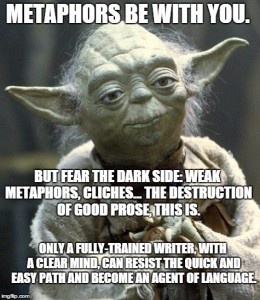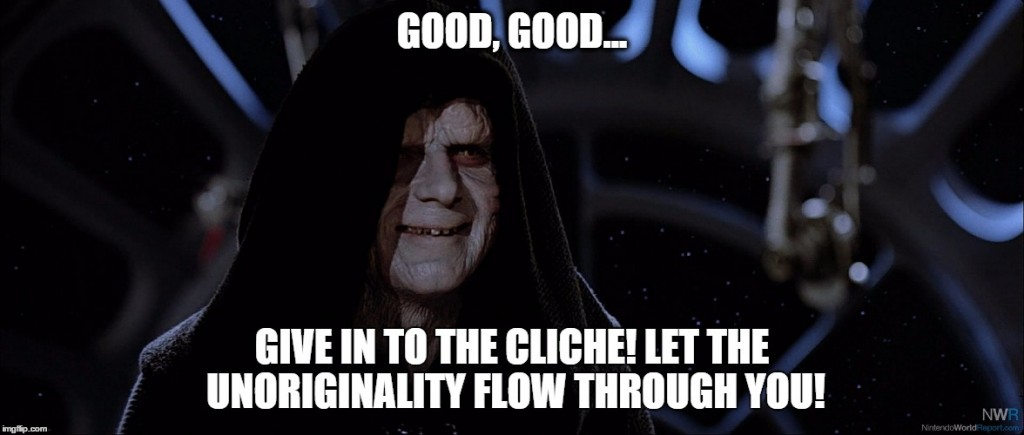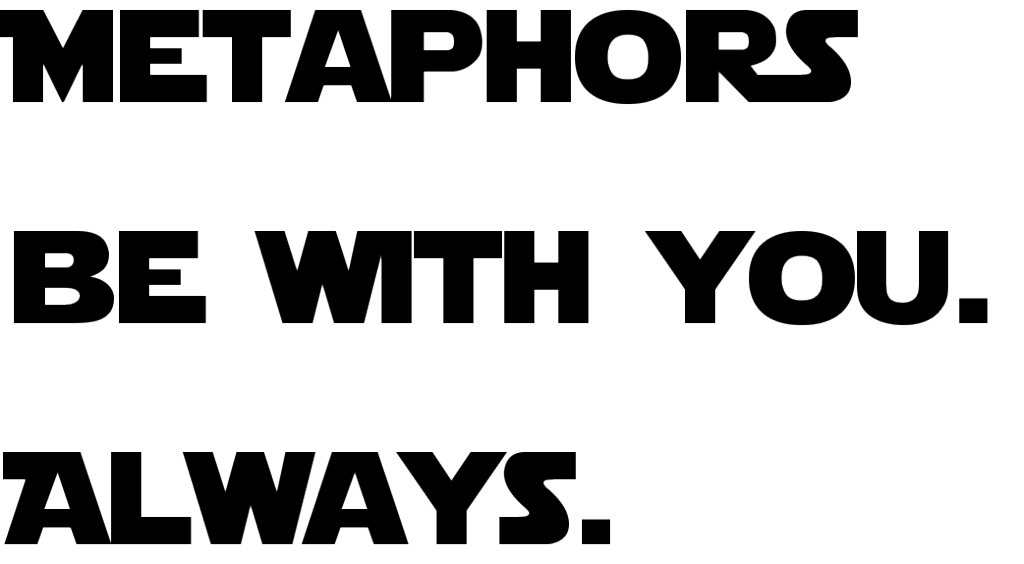 The concept of the metaphor underpins all of literature and many other aspects of society in general. Pick up any novel and you’ll find dozens of them. Listen to a speech and you’ll hear quite a few. But it goes further than that. For instance, the concept of the parable is essential to most religious texts. (Buddha wasn’t literally talking about fish. Jesus wasn’t literally talking about seeds. Muhammad wasn’t literally talking about boats. Wise men tend to use elegant metaphors a great deal.)
The concept of the metaphor underpins all of literature and many other aspects of society in general. Pick up any novel and you’ll find dozens of them. Listen to a speech and you’ll hear quite a few. But it goes further than that. For instance, the concept of the parable is essential to most religious texts. (Buddha wasn’t literally talking about fish. Jesus wasn’t literally talking about seeds. Muhammad wasn’t literally talking about boats. Wise men tend to use elegant metaphors a great deal.)
The concept of a thing being similar to another thing is inherently important to the human experience of communication. And yet, a lot of writers have difficulty in dealing with these comparisons. Let us learn about how to create better metaphors and how to avoid using bad ones.
A Thing and Another Thing
To an alien, human beings may seem strange for their use of metaphor: One thing is simply not another thing. The way in which often, physical, tangible objects are compared in speech and writing to convey a similar feeling to each other is honestly bizarre. And yet, most everyone understood Vincent Van Gogh when he said, “Conscience is a man’s compass.”
A conscience — an intangible concept connected with existing as a sentient being — is simply not a compass — a physical object meant to help bipedal apes find the right direction in which to travel. But most everyone can grasp their similarities: The moral “compass” is the conscience, which points out where to go when you’re morally lost. My even stating this might feel obtuse and obvious.
Surely, you don’t need to have this explained to you. But why not? How is your brain connecting those two things together to create a new level of understanding without an intense amount of thought?
In metaphors, two things or concepts feel similar while at the same time being not similar at all.
So How Is That Thing Like That Other Thing?
Without going into too much detail, most metaphors deal with what linguists refer to as the “conceptual domain.” One idea is understood in terms of the other. This is some dense, complicated stuff relating to psychology, schemas, and the way we process new information. Metaphors can help us map our experience; they cut through numerous concepts to bring new understanding.
We all use them because they have much less to do with language and much more to do with how we think. In a tangle of neurons in our brains, we are constantly building and rejecting new connections and creating synapses. The brain is wired to make new connections. A metaphor is an element of language, but it describes something that happens naturally as a part of cognition.
Why Are Some Metaphors Not as Good?
Really, anything goes, then, right? Well, no. When reading, it’s obvious that some metaphors are just better than other ones.
Weak Metaphors
As writers, we sometimes tend to make leaps and bounds from one thing to another thing, and the juxtaposition is rather strange and off-putting. When one makes a weak connection between two things that feature more dissimilarities than similarities, this is a weak metaphor. By and large, one will want to avoid speaking or writing about things that are ridiculously dissimilar, especially in anything other than experimental fiction.
But sometimes, this can be used on purpose to hilarious effect:
“The ships hung in the sky in much the same way that bricks don’t.”
Dying or Dead Metaphors
A dead metaphor is one that is so overused as a figure of speech and writing that it has lost its original meaning and hence its imagery. It’s become overused and thus a cliché. Here are some examples:
- A clean slate
- Nipped in the bud
- Step up to the plate
- Kick the bucket
- In the same boat
- Grasped a concept
- Run out of time
- Fall on deaf ears
- Writing on the wall
- Costs an arm and a leg
A really knowledgeable writer can see when a metaphor is on the verge of dying. It might not be commonplace, but it’s on the verge of becoming a cliché in writing. It might not be completely void of imagery, but it’s a bit worn out, like an old shoe. (See what I mean?) The imagery might be there, but it’s not strong. These metaphors should also be largely avoided.
You can use multiple metaphors at once, but when you keep going with more comparisons until they get jumbled illogically, these are mixed metaphors.
Here’s an example of a mixed metaphor from a speech by Boyle Roche made famous by Bryan A. Garner:
“Mr. Speaker, I smell a rat. I see him floating in the air. But mark me, sir, I will nip him in the bud.”
He’s going to nip a floating rat in the bud?
This is problematic for many people. When using several metaphors and jumbling them, you’ve both ended up with something that sounds ridiculous and lost the precious hold you had on readers’ imaginations.
Extended Metaphors
Metaphors can keep going and continue (or extend). Here’s an example of an extended metaphor from a pretty famous guy you may have heard of:
“All the world’s a stage, and all the men and women merely players; They have their exits and their entrances; And one man in his time plays many parts.”
Extended metaphors aren’t at all inherently bad, as most poets and fiction writers tend to use them a great deal. But sometimes they can be “hyper-extended,” so to speak, and reach the point where they stop making sense. Also, in professional contexts outside of poetry and fictional prose, extended metaphors can seem very awkward.
Allusion and Simile
Note that metaphors are different from allusions: Allusions are often references to other works. They call something to mind without explicit saying it.
Also, metaphors are not similes: Similes are similar, but they offer direct comparisons and often use the words “like” or “as.”
Building Stronger Metaphors
This is something very subjective; a “strong” metaphor is a matter of opinion. How you create a better metaphor is to think about the type of link you’re creating.
The two things might relate based on their imagery (the thing looks like or visually relates to the other thing) or their societal meaning (called a “root metaphor,” this metaphor relates two things based on a shared underlying worldview), for example. But they may relate in an almost indescribable way on an emotional or spiritual level, too.
Metaphors can be a lot of things: visual, conceptual, sensual, cultural, and logical.
Is there one right way to do a metaphor? Not really. I shudder to make sweeping generalizations, but in my personal experience, emotional, tangible, sense-focused comparisons (“His voice was fluttery like clothes on a line”) tend to be understood faster than rational or high-concept comparisons (“He made me nervous like I was interviewing for a job”).
Is faster better? That’s a matter of opinion.
Overuse and Matching Metaphor Usage With Tone
One of the worst parts of writing metaphors isn’t coming up with them but knowing when to use them. In creative pieces, you’re free to have a field day, but in most other types of writing, such as blogs, emails, white papers, news articles, and educational pieces, they tend to feel out of place. Even in creative works, a “field day” may be too much.
Before you use a metaphor to describe something, ask yourself the following questions:
- Will this convey something more efficiently on a cognitive/emotional level or help the reader conjure better imagery for the thing that’s being described?
- Is there no risk of the meaning being lost? Is this metaphor neither weak, dead, dying, nor hyper-extended?
- Does the metaphor match the tone? Is the metaphor appropriate or inappropriate for the audience? Will the audience quickly understand and relate to the metaphor?
- Is the metaphor memorable? Does it “stick”? Does it conjure an image, tell a story, or make a long-term impact on the overall piece?
If the answer to all of these questions is “yes” in your opinion, go for it.
Or just go for it anyway. You have the power to make these decisions. Even if it doesn’t make sense to one person, it may make sense to another. That’s just the power of subjectivity in art, which is where the metaphor truly originates. Experiment, play around with different combinations, and enjoy it.
In the meantime …


